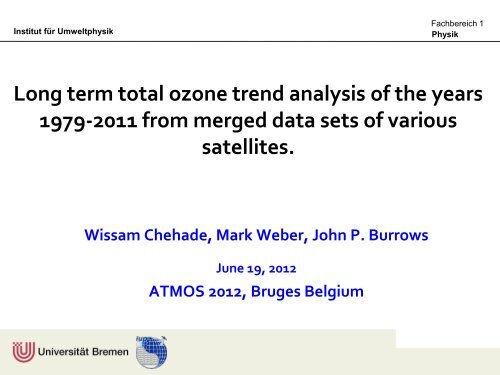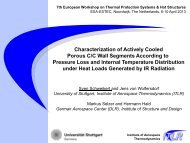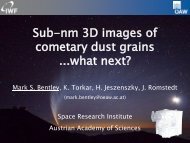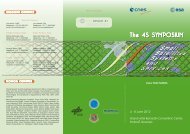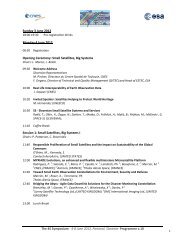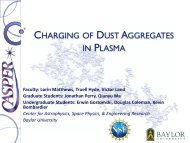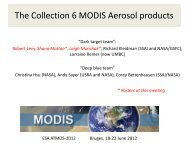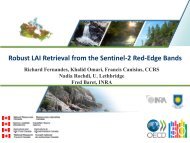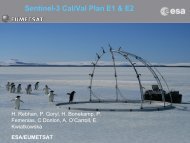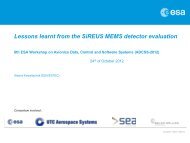Long term total ozone trend analysis
Long term total ozone trend analysis
Long term total ozone trend analysis
Create successful ePaper yourself
Turn your PDF publications into a flip-book with our unique Google optimized e-Paper software.
Institut für Umweltphysik<br />
Fachbereich 1<br />
Physik<br />
<strong>Long</strong> <strong>term</strong> <strong>total</strong> <strong>ozone</strong> <strong>trend</strong> <strong>analysis</strong> of the years<br />
1979-2011 from merged data sets of various<br />
satellites.<br />
Wissam Chehade, Mark Weber, John P. Burrows<br />
June 19, 2012<br />
ATMOS 2012, Bruges Belgium
Institut für Umweltphysik<br />
� Motivation.<br />
� Ozone datasets.<br />
Contents<br />
� Multiple linear regression.<br />
The main contributions to the <strong>ozone</strong> variability.<br />
� Results.<br />
� Summary and Conclusions.<br />
Fachbereich 1<br />
Physik
Institut für Umweltphysik<br />
Total <strong>ozone</strong> data sets:<br />
� WOUDC („ground“)<br />
Fachbereich 1<br />
Physik<br />
� SBUV/TOMS/OMI Mod V8 („US satellites“)<br />
� GSG data set („European satellites“)<br />
Montreal protocol:<br />
Ozone has leveled off after 2000 after a<br />
long <strong>term</strong> decline until the 1990s.<br />
large variability from year-to-year can still<br />
lead to substantial <strong>ozone</strong> losses at high<br />
latitudes in individual years in coming decades<br />
Weber et al., 2011b<br />
Motivation
Institut für Umweltphysik<br />
The „US“ <strong>total</strong> <strong>ozone</strong> record<br />
Ozone datasets<br />
Fachbereich 1<br />
Physik<br />
0<br />
TOMS, SBUV(/2) and OMI MOD V8 merged data set.<br />
http://acd-ext.gsfc.nasa.gov/Data_services/merged/instruments.html
The „European“ <strong>total</strong> <strong>ozone</strong> record (GSG)<br />
0<br />
Institut für Umweltphysik<br />
� GOME/ERS2: 1995-2011 (lost global coverage after 2003)<br />
o global coverage: ~3 days, large ground pixel: 320 x 40 km 2<br />
� SCIAMACHY/ENVISAT: 2002-2012<br />
o limb and nadir alternating, global coverage ~6 days<br />
� GOME-2/METOP-A: 2007-present<br />
o wide swath, daily coverage ~1 day, small ground pixel: 80 x 40 km 2<br />
Fachbereich 1<br />
Physik<br />
ERS2, ENVISAT, and METOP-A platforms<br />
WFDOAS <strong>ozone</strong> and overpass data: www.iup.uni-bremen.de/gome/wfdoas<br />
� GOME very stable over 16 year.<br />
� SCIAMACHY data corrected for <strong>trend</strong> (4%/decade), and bais of 1%.<br />
� GOME-2 corrected for bais of 1%.<br />
Ozone datasets
The main contributions to the <strong>ozone</strong> variability<br />
0<br />
Institut für Umweltphysik<br />
Fachbereich 1<br />
Physik<br />
Ozone depleting substances (ODS).<br />
o The various halogen compounds have different potentials to deplete stratospheric <strong>ozone</strong>.<br />
o EESC Equivalent Effective Stratospheric Chlorine<br />
http://acdb‐ext.gsfc.nasa.gov/Data_services/automailer/index.html<br />
� Solar cycle.<br />
o Decadal scale variation of <strong>total</strong> <strong>ozone</strong> correlates with the solar cycle.<br />
[Jackman et al., 1996; Miller et al.,1996]<br />
o The solar activity-<strong>ozone</strong> relationship considered in all international <strong>ozone</strong> <strong>trend</strong><br />
assessments (WMO,1999, 2003).<br />
o solar radio flux at 10.7 cm wavelength.<br />
ftp://ftp.ngdc.noaa.gov/STP/SOLAR_DATA/SOLAR_RADIO/FLUX/Penticton_Observed/monthly/<br />
� Major volcanic eruptions (aerosols).<br />
o Volcanic eruptions El Chichon in 1982 and Mt. Pinatubo in 1991, very low <strong>ozone</strong> in NH<br />
[Randel et al., 1995; Solomon et al., 1996].<br />
o Atmospheric dynamics and radiative forcing Effect [Solomon et al. 1996]<br />
o stratospheric aerosol optical depth at 550 nm.<br />
http://data.giss.nasa.gov/modelforce/strataer/
Institut für Umweltphysik<br />
� Quasi-Biennial Oscillation (QBO).<br />
0<br />
The main contributions to the <strong>ozone</strong> variability<br />
Fachbereich 1<br />
Physik<br />
QBO<br />
Quasi Biennial Oscillation QBO (zonal winds at 30 and 10 hPa)<br />
http://www.geo.fu‐berlin.de/en/met/ag/strat/produkte/qbo/index.html
0<br />
Institut für Umweltphysik<br />
� Eddy Heat Flux (ehf).<br />
The main contributions to the <strong>ozone</strong> variability<br />
Fachbereich 1<br />
Physik<br />
transport<br />
polar<br />
<strong>ozone</strong> loss<br />
Weber et al., 2011b
Multiple linear regression<br />
0<br />
Institut für Umweltphysik<br />
Fachbereich 1<br />
Physik<br />
Separate the influence of various dynamical and chemical processes.<br />
Multiple linear regression is a standard tool to quantitatively attribute observed<br />
<strong>total</strong> <strong>ozone</strong> variations to different natural and anthropogenic influences.<br />
[Steinbrecht et al.,2001, 2003; WMO, 2007]<br />
TOZ(n) = TOZ° + α EESC .EESC(n)<br />
+ α qbo10 .qbo10(n) + α qbo30 .qbo30(n)<br />
+ α solar .solar(n)<br />
+ α aerosols .aerosols(n)<br />
+ α ehf .ehf(n)<br />
+ ε(n)<br />
dynamics<br />
chemistry
0<br />
Institut für Umweltphysik<br />
8.21<br />
DU/decade<br />
QBO 4-5 DU, Solar Cycle ± 5 DU, Eddy Heat Flux ± 10 DU<br />
Fachbereich 1<br />
Physik<br />
3.71<br />
DU/decade
0<br />
Institut für Umweltphysik<br />
3.43<br />
DU/decade<br />
QBO 4-7 DU.<br />
Solar Cycle ± 3 DU.<br />
Fachbereich 1<br />
Physik<br />
1.96<br />
DU/decade
0<br />
Institut für Umweltphysik<br />
The influence of the QBO about 5 DU.<br />
The influence of the Solar Cycle up to 3 DU.<br />
Fachbereich 1<br />
Physik
0<br />
Institut für Umweltphysik<br />
Fachbereich 1<br />
Physik<br />
� The correlations between observed<br />
annual means and regression results are<br />
high.<br />
�EESC and Eddy heat flux <strong>term</strong>s<br />
contributions increase with latitude.<br />
� Eddy heat flux is dominant at high<br />
latitudes<br />
�QBO contribution from the tropics to<br />
subtropics
0<br />
A senstivity study on the use of the „GSG“ data in the linear regression is performed.<br />
Institut für Umweltphysik<br />
3.21<br />
DU/decade<br />
3.25<br />
DU/decade<br />
Fachbereich 1<br />
Physik<br />
3.43<br />
DU/decade
0<br />
Institut für Umweltphysik<br />
Fachbereich 1<br />
Physik
Institut für Umweltphysik<br />
Summary and Conclusions.<br />
Fachbereich 1<br />
Physik<br />
�Multiple linear regression <strong>analysis</strong> provides a good near global picture of natural and<br />
anthropogenic contributions to inter-annual variations of <strong>total</strong> <strong>ozone</strong>.<br />
�For the different explanatory variables, <strong>ozone</strong> fluctuations range about 3-10 DU.<br />
�The recent increases (2010) in both hemispheres <strong>total</strong> <strong>ozone</strong> are mainly related to<br />
increases in eddy heat flux (or reduced polar <strong>ozone</strong> loss after a series of cold Arctic<br />
winters in the mid-nineties ).<br />
�For the 2011 decrease, we had the opposite, QBO west phase, little wave activity<br />
and strong chemical <strong>ozone</strong> loss.<br />
� SBUV/TOMS/OMI/GSG shows about the same significance in the overall fitting as<br />
SBUV/TOMS/OMI.<br />
�The fingerprint of recovery is less clear due to the large influence from<br />
atmospheric dynamics.
Institut für Umweltphysik<br />
THANK YOU<br />
Fachbereich 1<br />
Physik


